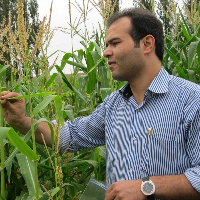Evaluation of Yield, Yield Component and Usefulness Indices of Bean (Phaseolus vulgaris) and Maize (Zea mays) Intercropping under Inoculation with Rhizobium phaseoli
Intercropping involves cultivating two or more crops together in the same field within a single cropping year. One common method to supply nitrogen to plants is through the use of chemical fertilizers containing nitrogen. However, excessive use of nitrogen fertilizers conflicts with the principles of sustainable agriculture. An alternative approach is to utilize microorganisms capable of nitrogen fixation, such as rhizobial bacteria and non-symbiotic bacteria (Azospirillum, Herbaspirillum, Azotobacter, etc.). The purpose of this study is to evaluate the usefulness of intercropping of Guilan bean (Phaseolus vulgaris) landrace and maize (Zea mays) under inoculation with Rhizobium phaseoli.
The present study was conducted in Talesh, Guilan province as split plots based on the randomized complete block design with three replications. Main factor was use of bacteria at two levels (inoculation and non-inoculation) and the split factor was the ratio of maize-bean intercropping in five levels (monoculture of maize and bean, 25% bean + 75% maize, 50% bean + 50% maize and 75% bean + 25% maize). Maize and bean seeds were planted simultaneously on May 22, 2022. Beans were harvested in late of August and maize was harvested in mid-September. Each gram of inoculant contained 107 bacterial cells. To inoculate with bacteria, the seeds were first coated with arabic gum and then 10 grams of inoculant was added per one kilogram of seeds. Planting was done after half an hour and drying the inoculated seeds in the shade. After measuring seed yield at harvest, various indices were used to evaluate the effectiveness of intercropping, including the Land Equivalence Ratio (LER), Relative Crowding Coefficient (RCC), Competition Ratio (CR), Aggressivity, and Relative Value Total (RVT). The analysis involved variance assessment, mean comparisons, and calculations of intercropping usefulness indices, all performed using R software.
In bean, the effect of inoculation were significant on plant height, number of pods per plant, number of seeds per pod, pod length, hundred seed weight, biological yield, seed yield, harvest index and the effect of intercropping were significant on plant height, number of pods per plant, number of seeds per pod, biological yield, seed yield and harvest index and the interaction effects of two factor were significant on plant height, biological yield and seed yield. In maize, the effect of inoculation were significant on plant height, ear length and grain yield. The effect of intercropping were significant on plant height, ear length, number of grains in ear, grain yield, biological yield and harvest index and interaction effects of two factor were significant on ear length and hundred grain weightUnder both inoculated and non-inoculated conditions, the Land Equivalence Ratio (LER) exceeded 1 across all intercropping ratios, demonstrating the superiority of intercropping over monoculture in these systems. The highest LER and Relative Crowding Coefficient (RCC) were observed in the planting ratio of 75% bean + 25% maize under inoculated conditions, indicating that inoculation enhanced the yield of both species compared to non-inoculated conditions. In the inoculated condition, the Competition Ratio (CR) was greater than 1 for beans and less than 1 for maize across all intercropping ratios. However, under non-inoculated conditions, for the ratios of 75% bean + 25% maize and 25% bean + 75% maize, the CR was greater than 1 for maize and less than 1 for beans. This shift indicates that maize had a lower competitive ability compared to beans in inoculated conditions within the mixed cropping system. The Aggressivity index for beans was positive under inoculated conditions across all three intercropping ratios, further supporting its competitive advantage. The Relative Value Total (RVT), which combines the RVT values of beans and maize, was greater than 1 in all intercropping ratios, highlighting the economic benefits of mixed cropping compared to monocropping of either species.
In general, for the sustainable production of crops, the intercropping of bean and maize under inoculation with rhizobium bacteria can be one of the suitable solutions to reach the optimal yield performance.
-
The effect of co-inoculation of bradyrhizobium and mycorrhizal species on physiological traits and grain yield of soybean (Glycine max L.) under drought stress
Mohammadali Zirak Qoturbulagh, Shahram Mehri*, Hossein Soleimanzadeh, Mohammadhossein Ansari
Journal of Iranian Plant Ecophysiological Research, -
Biochemical Responses of Calendula officinalis to Drought Stress Under Abiotic Elicitor Treatments
Asgar Yari, Shahram Sedaghathoor *, Mohammad Naghi Padasht,
Journal of Ornamental Plants, Summer 2024



